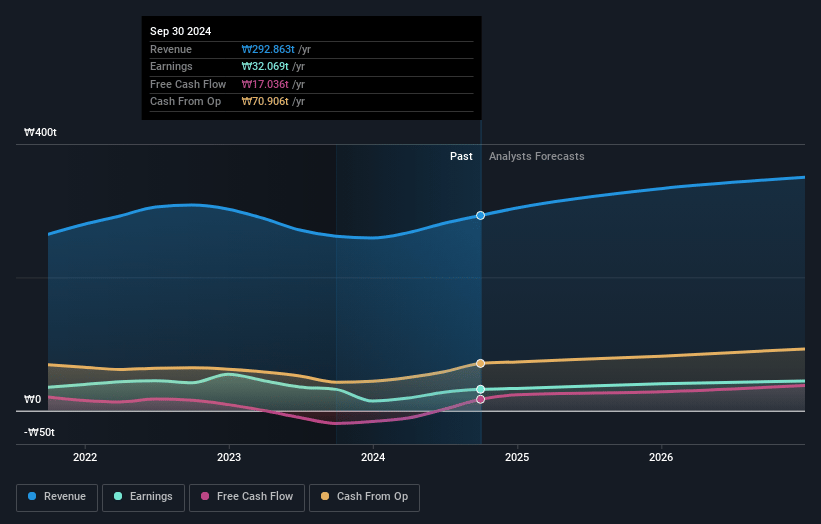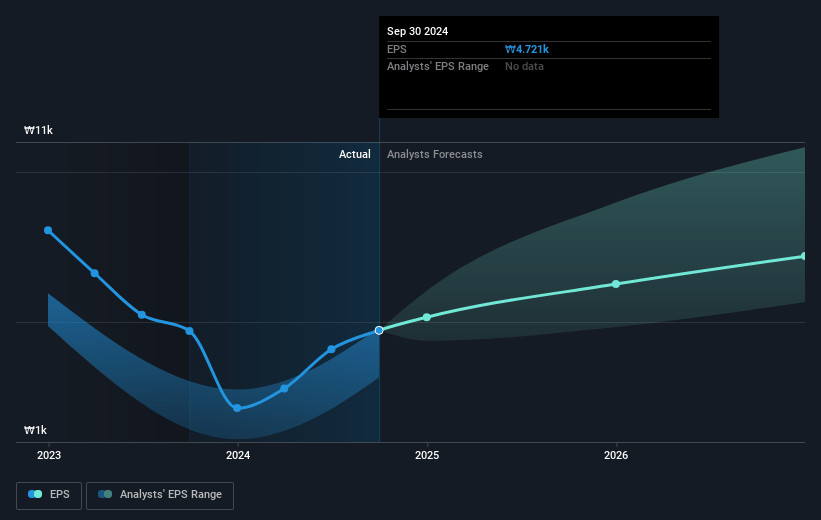Narratives are currently in beta
Key Takeaways
- Focus on high-margin products and strategic technology investments is expected to drive sales growth and enhance competitiveness.
- Strategic alignment and selective investments suggest a pivot towards profitability, potentially improving net margins and operational efficiency.
- Rising competition and macroeconomic uncertainties threaten Samsung's revenue growth and profitability, while high R&D spending challenges maintaining technological competitiveness.
Catalysts
About Samsung Electronics- Engages in the consumer electronics, information technology and mobile communications, and device solutions businesses worldwide.
- Samsung's increased focus on advanced technology investments, like the development and mass production of the 2-nanometer GAA process, aims to enhance competitiveness and secure high-value orders, potentially boosting revenue.
- The prioritization of high-margin products such as HBM3E and the expansion of the server SSD market are expected to drive sales growth in both 2024 and 2025, positively impacting earnings.
- Plans for extensive process node conversions and selective CapEx investment in advanced technologies rather than broad capacity expansion suggest a strategic pivot towards profitability, which may improve net margins.
- Enhanced AI functionality and AI-driven product innovations across Samsung’s extensive product lines in mobile, home appliances, and displays are expected to bolster revenue through increased product differentiation.
- The strategic alignment and integration of various units like Memory and Foundry, coupled with the adoption of advanced technologies, imply operational improvements that may lead to enhanced earnings efficiency over time.
Samsung Electronics Future Earnings and Revenue Growth
Assumptions
How have these above catalysts been quantified?- Analysts are assuming Samsung Electronics's revenue will grow by 5.1% annually over the next 3 years.
- Analysts assume that profit margins will increase from 9.9% today to 11.0% in 3 years time.
- Analysts expect earnings to reach ₩37232.5 billion (and earnings per share of ₩5547.44) by about January 2028, up from ₩28913.9 billion today. However, there is a considerable amount of disagreement amongst the analysts with the most bullish expecting ₩60456.0 billion in earnings, and the most bearish expecting ₩26862.0 billion.
- In order for the above numbers to justify the analysts price target, the company would need to trade at a PE ratio of 17.4x on those 2028 earnings, up from 12.8x today. This future PE is greater than the current PE for the GB Tech industry at 10.8x.
- Analysts expect the number of shares outstanding to decline by 0.4% per year for the next 3 years.
- To value all of this in today's terms, we will use a discount rate of 8.05%, as per the Simply Wall St company report.
Samsung Electronics Future Earnings Per Share Growth
Risks
What could happen that would invalidate this narrative?- Rising competition in the display and mobile segments may constrain revenue growth, particularly as the company anticipates intensifying competition in mobile displays and panel makers, impacting net margins.
- Declines in operating profit due to one-off costs and unfavorable currency exchange rates hint at potential volatility in earnings, with ₩1.3 trillion reduction in profitability, highlighting sensitivity to external financial factors.
- Persistent macroeconomic uncertainties and slow recovery in global consumer demand could limit sales growth opportunities, especially in the mobile and PC sectors, affecting overall revenue.
- Reduced outlook for mobile demand and competitive pressure from Chinese companies could hinder Samsung's ability to maintain its current sales trajectory in traditional and emerging markets, impacting revenue from mobile and memory divisions.
- High and increasing R&D expenditure without proportional revenue increases poses a risk to net margins as Samsung strives to maintain technological competitiveness amid fluctuating revenues from key product sectors.
Valuation
How have all the factors above been brought together to estimate a fair value?- The analysts have a consensus price target of ₩76477.14 for Samsung Electronics based on their expectations of its future earnings growth, profit margins and other risk factors. However, there is a degree of disagreement amongst analysts, with the most bullish reporting a price target of ₩125000.0, and the most bearish reporting a price target of just ₩48000.0.
- In order for you to agree with the analyst's consensus, you'd need to believe that by 2028, revenues will be ₩340005.5 billion, earnings will come to ₩37232.5 billion, and it would be trading on a PE ratio of 17.4x, assuming you use a discount rate of 8.0%.
- Given the current share price of ₩54300.0, the analyst's price target of ₩76477.14 is 29.0% higher.
- We always encourage you to reach your own conclusions though. So sense check these analyst numbers against your own assumptions and expectations based on your understanding of the business and what you believe is probable.
How well do narratives help inform your perspective?
Disclaimer
Warren A.I. is a tool utilizing a Large Language Model (LLM) that ingests data on consensus price targets, forecasted revenue and earnings figures, as well as the transcripts of earnings calls to produce qualitative analysis. The narratives produced by Warren A.I. are general in nature and are based solely on analyst data and publicly-available material published by the respective companies. These scenarios are not indicative of the company's future performance and are exploratory in nature. Simply Wall St has no position in the company(s) mentioned. The price targets and estimates used are consensus data, and do not constitute a recommendation to buy or sell any stock, and they do not take account of your objectives, or your financial situation. Note that Warren A.I.'s analysis may not factor in the latest price-sensitive company announcements or qualitative material.
Read more narratives
There are no other narratives for this company.
View all narratives



